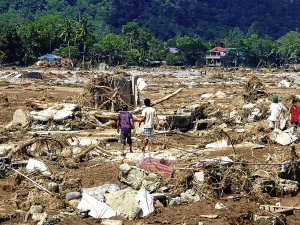Viewer-hooking gambits distract from well-meaning coverage

Rampaging waters from the Cagayan de Oro River swept away this entire community of some 400 households in Sitio Kala-Kala, Barangay Macasandig, in Cagayan de Oro City. BOBBY LAGSA/INQUIRER MINDANAO
THE TV coverage of treacherous and deadly Tropical Storm “Sendong” has left the concerned and involved televiewer in a decidedly conflicted mood: First, he’s grateful to the television networks for devoting so much valuable airtime to informing viewers about the calamity and the many rescue and relief efforts being mounted to find the missing, care for survivors, and bury the dead.
Going beyond mere reportage, TV outfits have mounted their own fund drives and relief initiatives, even using their stars to generate interest, as well as to make disaster victims feel that the nation deeply cares for their welfare.
On the other hand, some people think that the “stellar” caring and other public displays of concern and emotion have gone “over the top” and become self-serving. This sounds terribly ungrateful of them, but they point to some “signs and symptoms” to prove the validity of their changes:
Spotlight
They ask, why does most of the coverage on the tube focus on the channels’ relief efforts, while the similarly important initiatives of other groups are relatively left uncovered, or given much less TV time? Doesn’t this indicate that the TV outfits are using their coverage to shine the spotlight on themselves and their stable of luminaries, partly for PR or “institutional advertising” purposes? Why can’t they do their relief efforts away from the cameras, so that they won’t be accused of “user-friendly” tactics?
This reaction has disappointed and even shocked some TV people, who swear that they have only the flood victims’ welfare at heart. They argue that the coverage is needed to inform viewers of the great need for help and succor, and their stars have been sent to the disaster sites to inspire viewers to help by donating in cash and kind to the ongoing relief initiatives, or to volunteer to care and feed Sendong’s thousands of victims. How dare their critics doubt their sincerity, when all they’ve contributed to the situation is their smug and rancid cynicism?
Caught between this dilemma’s huge horns of dissention are the confused viewers and the flood victims. Initially, they are deeply grateful for the channels’ help—but, nobody likes being used.
For our part, we believe that the TV coverage basically springs from the genuine desire to inform and help—or, more properly put, to help by informing, which is what TV does best. Thus, we don’t ascribe “user” motives to the channels’ efforts.
Emphasis
We would like to point out, however, that some parts of the coverage focus on subjective, and therefore distracting and counterproductive aspects of the disaster, like an excessive emphasis on melodramatic emotionalizing, superstition and “oddities.”
The tendency to “highlight” victims who break down, cry out and tell floridly emotional tales of pamamaalam and kababalaghan directly “plugs into” local TV’s “teleserye mentality,” which avidly looks for both high and low melodrama even in real-life events and tragedies.
TV people use it to “connect” more personally with viewers, but the overly emotional and “produced” results rankle, because they’re too exploitative. So, please desist.